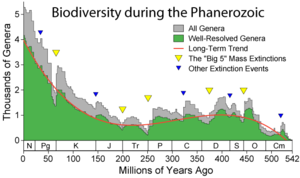 |
| Apparent Marine Fossil Diversity (from Wikipedia) |
It is recognized that biodiversity is critical to maintain ecosystem functions favourable for us and to benefit directly from ecosystem services. It took hundred of million years of evolution to build up modern levels of biodiversity. Thus evolution of species seems to foster their diversity. That in turn is a indicator, that biodiversity is important for ecosystems and the species forming it.
Ecosystem functions are ecological processes that control the fluxes of energy, nutrients and organic matter through an environment. Ecosystem services are the suite of benefits that ecosystems provide for humanity, such as provisioning of renewable resources and regulating of climate or disease control.
 |
| Find out about threat to marine biodiversity. |
Bradley J. Cardinale and co-workers [2] discuss impact of biodiversity loss on humanity in terms of ecosystem functions and ecosystem services. Their analysis may be framed in six statements and two considerations drawn from their article (**):
Statements - Biodiversity Consensus
- There is now unequivocal evidence that biodiversity loss reduces the efficiency by which ecological communities capture biologically essential resources, produces biomass, decompose and recycle biologically essential nutrients.
- There is now sufficient evidence that biodiversity per se either directly influences or is strongly correlated with certain provisioning or regulating ecosystem services.
- There is mounting evidence that biodiversity increases the intrinsic stability of ecosystem functions through time.
- The impact of biodiversity loss on a single ecosystem process is non-linear and saturating, such that change accelerates as biodiversity loss increases.
- Diverse communities are more productive because likely they contain more key species that have a large influence on productivity, and differences in functional traits among organisms increases total resource capture.
- Loss of biodiversity across trophic level (*) level has the potential to influence ecosystem functions even more strongly than biodiversity loss within trophic level, and functional traits of organisms have large impacts on the magnitude of ecosystem functioning.
Considerations
- Today, for many ecosystem services there is mixed evidence and insufficient data to evaluate, beyond its contribution per se, the relationship between biodiversity, ecosystem services and their trade-offs.
- Ecosystems deliver multiple services, and many involve trade-offs in that increasing the supply of one reduces the supply of another. The value of biodiversity change to society depends on the net marginal benefits of biodiversity – in terms of services gained – relative to marginal costs – terms of services lost.
The benefit of biodiversity for functioning of human societies seems beyond doubt. Also it seems established that the impact of biodiversity loss on ecological processes might be as large as the impact of other global drivers of environmental change. Thus, in view of pressure of global human population and its (current) manner of production and reproduction on global ecosystems - e.g. plundering of marine resources [3] - the quantification of impacts of biodiversity loss is needed.
The best available evidence solidly confirms firm qualitative relationships between biodiversity and ecosystem services. However, currently understanding is missing to establish the solid quantitative relationships that would be a prerequisite to assess biodiversity loss in monetary values. Particular difficulties arises when trade-offs between different ecosystem services is to be taken into account.
 |
| Front page NOAA's National Marine Fishery Service |
p.s. Curious about your feedback regarding how statements and considerations apply to marine biodiversity and marine biodiversity losses.
Martin.Mundusmaris@gmail.com
info@mundusmaris.org
(*) trophic level: "The trophic level of an organism is the position it occupies in a food chain. The word trophic derives from the Greek τροφή (trophē) referring to food or feeding. A food chain represents a succession of organisms that eat another organism and are, in turn, eaten themselves. The number of steps an organism is from the start of the chain is a measure of its trophic level. Food chains start at trophic level 1 with primary producers such as plants, move to herbivores at level 2, predators at level 3 and typically finish with carnivores or apex predators at level 4 or 5. The path along the chain can form either a one-way flow, or a food "web." Ecological communities with higher biodiversity form more complex trophic paths." (from WIKIPEDIA)
(**) The statements and considerations are largely written by paraphrasing wording used by the authors. The reader is referred to the original article for their exact wording. Any error or distortion is my mistake.
(**) The statements and considerations are largely written by paraphrasing wording used by the authors. The reader is referred to the original article for their exact wording. Any error or distortion is my mistake.
No comments:
Post a Comment